A GENERATION after Honda’s game-changing late-’80s supercar followed the last great Civics to the afterlife, the Honda NSX returns with a completely new set of skills.
WHAT IS IT? The long-overdue replacement for Honda’s original NSX (1990-2005), and the halo model for Honda’s intended brand renaissance as a sort of ‘Japanese BMW’, the reputation it earned in the ’80s. These days, Honda struggles to compete with Toyota.
WHY WE’RE TESTING IT? We’ve joined the very last wave of the NSX’s European launch program – prior to its launch in Asia – centring on the famous racetrack at Estoril in Portugal and some tight Rally of Portugal roads in the surrounding hills.
MAIN RIVALS At the fully loaded NSX’s $420,000 price point, Audi R8 V10 Plus, Porsche 911 Turbo, and if you’re genuine tech nerd, BMW’s much cheaper (but also much slower) i8.
THE WHEELS VERDICT PLUS: Accessible supercar performance and dynamics; intriguing tech; handsome body and rear end; unexpected refinement; excellent carbon-ceramic brakes; promise of bulletproof reliability and serviceability MINUS: Can’t make up your own dynamic settings (mixing sport+ induction/exhaust/transmission with comfort damping); dorky front-end styling; flat seats; cabin hardware isn’t special enough for the price
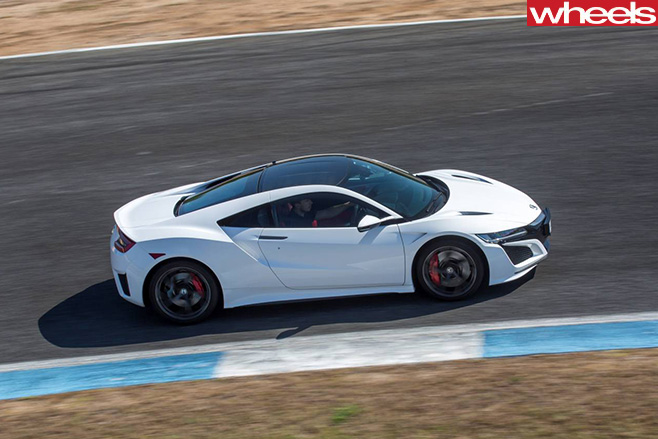
THE WHEELS REVIEW IT IS easy to be cynical about the new Honda NSX. The Japanese outfit’s regular line-up contains some depressingly mediocre product with barely a hint of sporting sparkle, yet here we have a $420,000 hybrid supercar, to be built at the rate of just 1500 a year, that appears to be about as relevant as a gym membership in jail. The last thing the world needed was yet another supercar.
But Honda did, even though this car’s presence will be so negligible you’ll be lucky if you ever see one. The new NSX is a glimmer of hope on the horizon for a brand that used to be seen as Japan’s BMW, a rallying point for a company mired in chasing sales numbers over building great cars. So this rare, expensive exotic is more than just a belated attempt at replacing the game-changing 1990-2005 original. It’s a signal that ‘Power of Dreams’ may soon mean something more than just an empty marketing slogan.
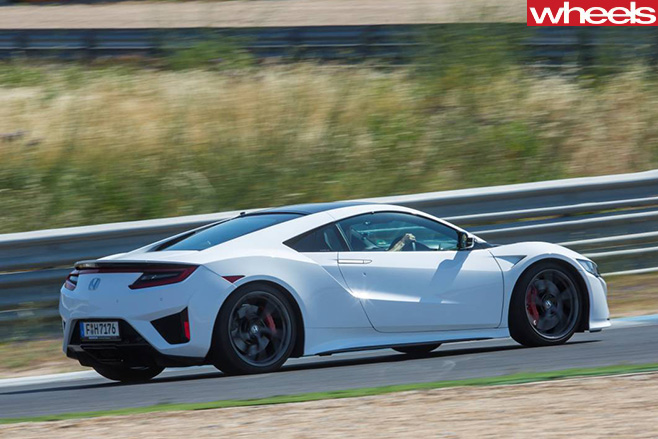
Based on the Acura (Honda’s upmarket US-only brand) NSX Concept that made its debut at Detroit in 2012, but promised since the Acura Sports Car Concept of 2007, it took Honda several attempts to decide exactly what the second-generation NSX was going to be. But they kept coming back to one thing – the “Advanced Sports Package” concept that drove the aluminium-bodied, mid-engined V6 original needed to live on in its new-millennium replacement.
The result is a true global collaboration. Built around an aluminium-intensive spaceframe chassis, its sharply creased ‘Interwoven Dynamic’ exterior is the work of the Honda Design Studio in Los Angeles. Given the tough ask of managing both enough cooling air for the hybrid NSX’s 10 heat exchangers, enough aerodynamic downforce to support a 308km/h top speed, and enough presence to fulfil its supercar brief, the NSX is put together at Honda’s US manufacturing facility in Ohio, including its all-new, completely bespoke and hand-built 3493cc twin-turbo V6 engine.
Claiming best-in-class rigidity for both bending and torsional stiffness by a significant margin, the NSX employs extensive aluminium construction and some world-first construction techniques, as well as a carbonfibre front floor, aluminium side pressings, doors, bonnet and roof, sheet moulding composite (SMC) plastic front and rear guards, and rear bootlid skin (over an aluminium inner structure) to further bolster its exotic status. And while its suspension system – an all-aluminium double-wishbone arrangement up front and a sophisticated multi-link rear, with adaptive third-generation ‘magnetorheological’ dampers – might sound a bit more common, there’s nothing normal about its drivetrain configuration.
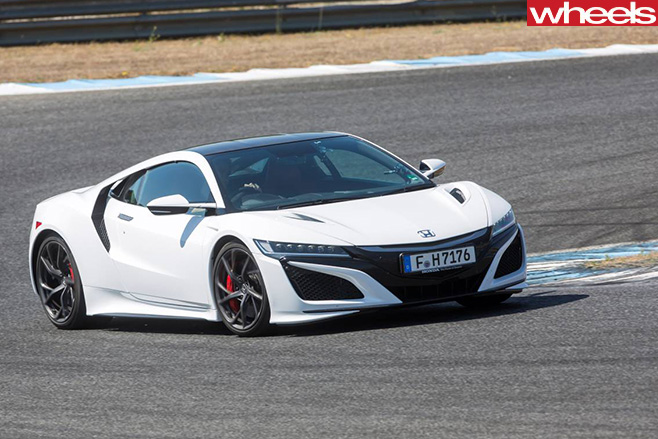
The combustion engine itself punches out 373kW from 6500-7500rpm and 550Nm from 2000-6000rpm, while the rear electric motor is good for 35kW at 3000rpm and 147Nm between 500 and 2000rpm. But that’s not all.
Up front resides a Twin Motor Unit (TMU), which uses two electric motors independently powering the left and right front wheels, good for 27kW at 4000rpm and 73Nm from 0-2000rpm.
Off the line, the electric motors provide that instant torque kick the twin-turbo engine can’t, while the TMU delivers not only front-wheel traction, it also supplies torque vectoring (in much the same way that a closely related system worked at the rear end of the last ‘SH-AWD’ Honda Legend). And if you plant the right pedal at cruising speeds, the electric motors provide supplementary power and yaw control for an instant kick in the slats that feels seriously supercar-rapid.
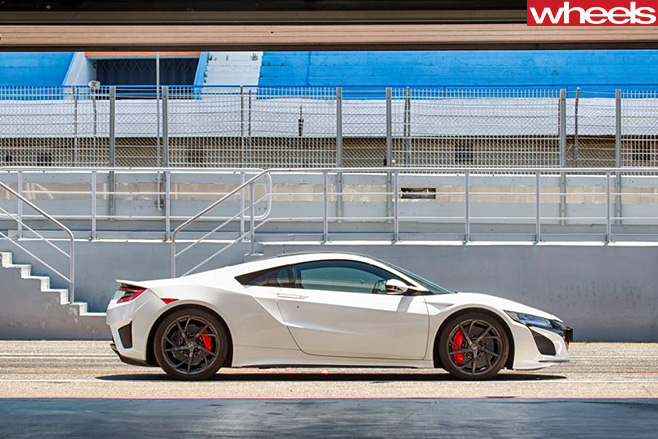
Our first test of the new NSX’s towering technical complexity is at the brilliant Estoril racetrack in Portugal. First stint out, we perform four laps, beginning in the first of four integrated dynamic modes (accessed via a large controller in the middle of the centre stack) which Honda has dubbed ‘Quiet’. Or, if you prefer, ‘Neighbour Pleasing’ mode.
In Quiet, the suspension remains in its default ‘Normal’ mode, the engine’s induction-sound enhancer (plumbed to the cabin behind each headrest) remains off, and so too does the active rear exhaust. It still clearly delivers acceleration in spades, yet there’s a seductive edge missing from its acoustics (engine revs are capped at 4000rpm) and the stability control makes its presence known if you ask for full thrust when exiting some of Estoril’s late-apex corners.
‘Sport’ (the NSX’s default setting at start-up) maintains soft-cock Quiet’s suspension tune, but tweaks the throttle and transmission mapping, and allows the induction and exhaust to open up more, particularly under full-throttle acceleration. It also enables closer dynamic analysis on the base chassis setting, which is pleasingly fluent, with impressively consistent steering connection given all the wizardry going on underneath, yet there’s probably a smidge too much understeer for racetrack purposes. Why would you bother, anyway, when ‘Sport+’ and ‘Track’ are merely the twist of a dial away?

Bodyroll is noticeably reduced, while the NSX’s chassis balance clearly favours the rear end more, with subtle oversteer drifts when powering out of corners both satisfying and effortlessly achievable when you trail a touch of brake into a corner, then quickly squeeze on the juice.
Track is the NSX’s final dynamic step, and, not surprisingly, the most flattering at Estoril. Not only does it activate launch control – settling the Honda’s digital tacho needle at just above 2000rpm before punching the car of the line – but it makes the 9DCT ’box’s upshifts scalpel-sharp, retunes everything from the pedal feel of the NSX’s regenerative brakes to its SH-AWD system and drivetrain acoustics, and broadens the ESC’s safety net. It even prioritises the lithium-ion battery state-of-charge to maintain a consistent level of torque delivery for the three electric motors. It’s also the only mode where you can fully disable stability control, though not for journalists apparently. That demonstration is still to come…
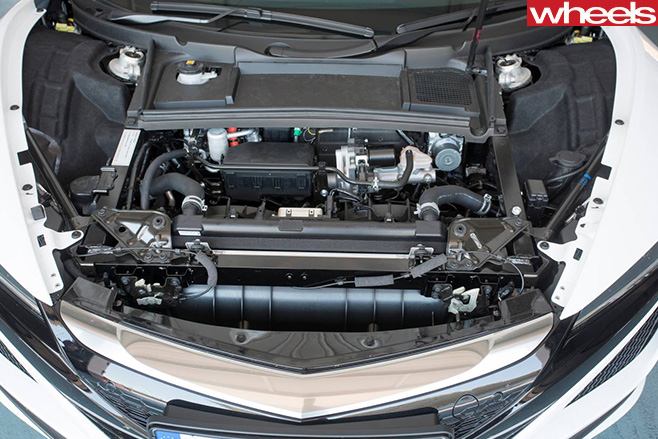
On Estoril’s back straight, the NSX easily touches 220km/h, while on the front straight, 250km/h and beyond is a relative doddle. In fact, while being quick with this car still requires placement, input progression and an understanding of balance, it’s an incredibly easy and effortless supercar to drive super-fast. Only when pushed too hard on the wrong line does understeer intrude, and even then, it’s only a subtle lift away from being back in the game.
At max-attack, its drivetrain sounds pretty serious. Honda’s nine-speed dual-clutch is a magnificent gearbox, pre-empting your every move far better than I manage on its slightly cheap-feeling wheel paddles, and somehow upshifting with both rapidity and subtlety. Benchmarked against Porsche’s PDK dual-clutch, Honda’s attempt is every bit as brilliant as the German’s marque’s best.
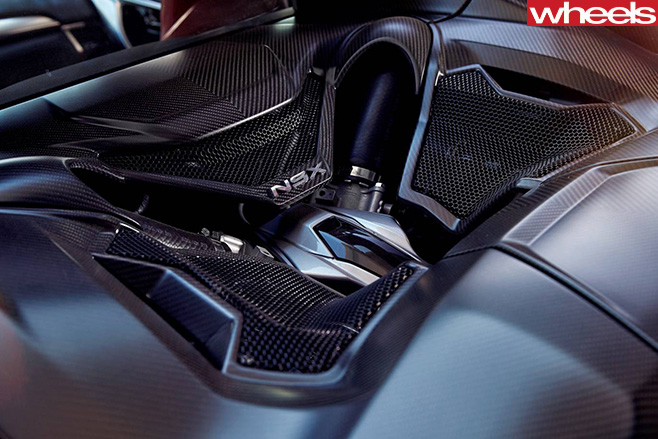
Finally, it’s the turn of English GT3 driver Nick Edwards to demonstrate what the NSX can do with its safety electronics sent to the naughty corner. In time-honoured all-wheel-drive fashion, it’s all in the trail-braking while turning in as Nick flicks the NSX into a corner and traces some beautifully smooth sideways arcs. For the first time, I can hear the NSX’s Continental ContiSportContact 5SP tyres (245/35ZR19 front, 305/30ZR20 rear) truly howling. It’s a noise that signals Honda’s choice of a ‘Super Hybrid’ all-wheel-drive set-up was a wise decision.
As Jason Bilotta, chief program engineer for the NSX, pointed out, the aim was to “focus on the driving experience rather than how to drive the car”. But I can’t help thinking that some track-savvy purists, particularly those infatuated with anything rear-engined, may find Japan’s new supercar perhaps a bit too effortless.
Out on real roads, the NSX’s multiple personalities shine in a different fashion. In limp-wristed Quiet mode, the car is a borderline embarrassment at low speeds because it’s so, erm, quiet. Not the battery part – that’s actual silence. More the whirring bit, as if there’s a twin or triple mounted behind your ears, yet without the velvety polish of the BMW i8’s turbo-triple.
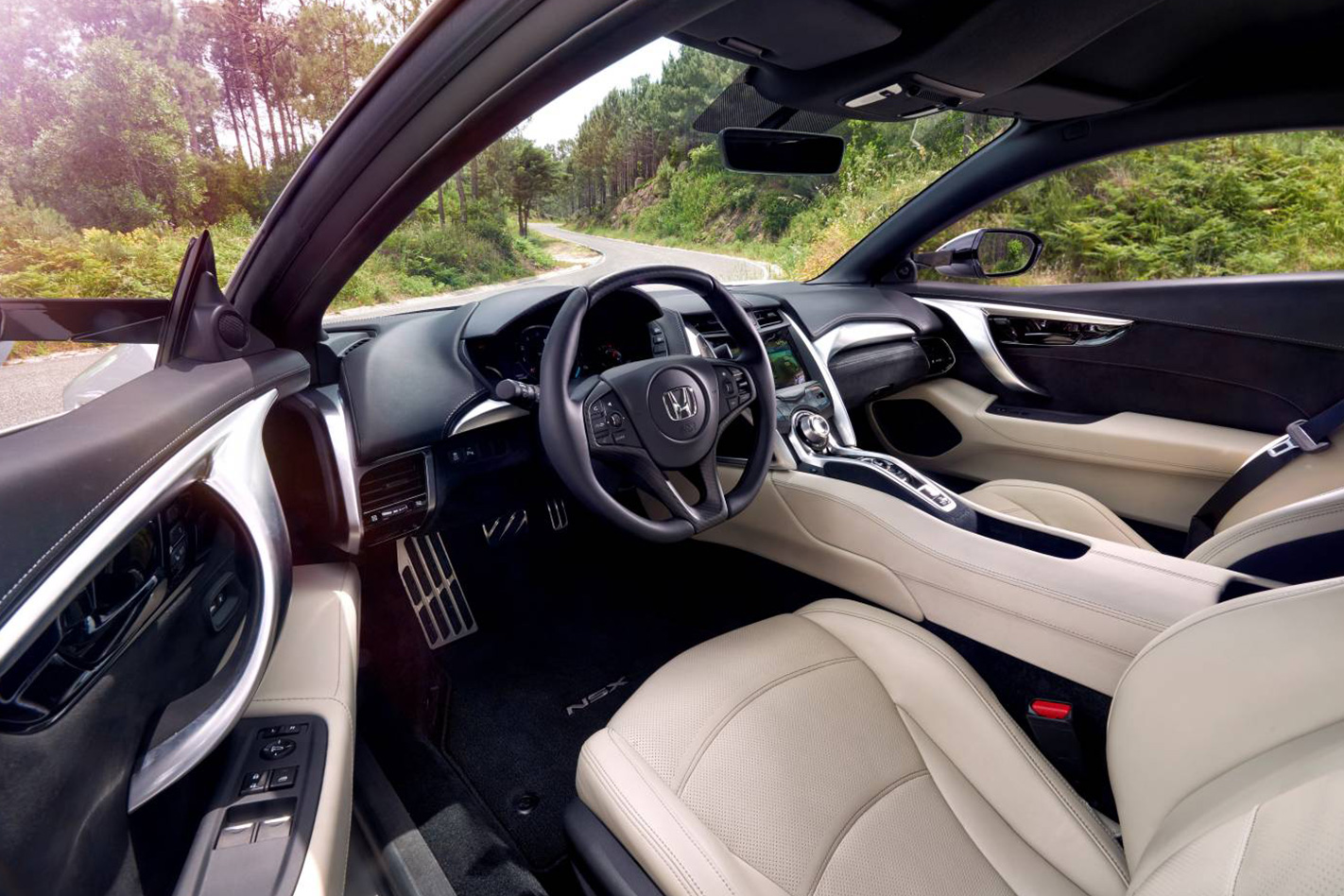
It’s out on the fast, 120km/h-signposted motorways surrounding Lisbon that the NSX starts to shine again. In the drive settings’ default Sport mode, the magnetic dampers favouring comfort, its ride is brilliant, and so is its refinement, especially considering it has a carbonfibre front floor. In really strong winds, the NSX carves its way through the bluster, sitting on a comfortable 2700rpm at the old imperial ton (161km/h), backed by an audible, if far from hardcore, V6 burble.
In Sport+, the NSX’s ride is much firmer, but still not unpleasant. Its engine note and thrust are clearly amped, and the only way you’ll get ninth gear is if you select it manually. But we keep coming back to the effortlessness of the NSX’s ride and waftability in Sport. This would be a great autobahn stormer.
It’s pretty impressive up in the hills, too. Hammering along some unpredictable old Rally of Portugal roads, the NSX again defies its 1780kg ballast by easily tracing tight cornering lines. While you can feel the front-end torque vectoring and yaw-control smarts working at times, it’s far better integrated and seamless than, say, similar set-ups used to be in Mitsubishi Evos. And the NSX’s steering continues to impress with its uncorrupted smoothness and effortless communication.
Belting back to the airport at a blissfully Portuguese pace (ie. well over the speed limit), a few chinks in the NSX’s driveability armour finally begin to show. Not its transmission, which is wonderful, or in the seamless union of its combustion engine and battery power, but in mundane things.
Its seats, for example, only have simple four-way electric adjustment and feel desperately lacking in under-thigh support after several hours behind the wheel. Then there’s some of its cabin switchgear, which simply isn’t special enough for $400 grand. Chief offender is the plasti-silver coating of the dash inlay and (excellent) door grips. If it’s metal, it does an amazing job of looking like plastic. Pity the 2012 NSX concept’s genuine carbonfibre inserts never made it to production. And the same sat-nav set-up as a Civic doesn’t belong either, particularly when it’s so annoyingly inept.
But these are relatively minor blemishes on the technical achievement that is the new NSX. It’s not a supercar for everyone, and in some ways, it’s almost the anti-supercar. Quiet when the others are crowing, calm when it could be challenging. Then there’s the look, which really works from some angles (the rear), and really doesn’t from others (the front). But I have a feeling Honda will have no trouble flogging 1500 NSXs per annum when production is in full bloom.
What really needs to happen, though, is for the NSX’s engineering and sporting focus to infuse its way back down the Honda line-up. That’s the promise. But if it doesn’t happen, cynics who envisaged the new NSX as nothing more than a vanity project will be proven smugly correct.
SPECS Model: Honda NSX Engine: 3456cc V6 (75°), dohc, 24v, twin-turbo + 3 electric motors Total system power: 427kW Total system torque: 646Nm Transmission: 9-speed dual-clutch Weight: 1780kg 0-100km/h: 3.0sec (estimated) Fuel economy: 10.0L/100km (EU) Price: $420,000 On sale: First half 2017





